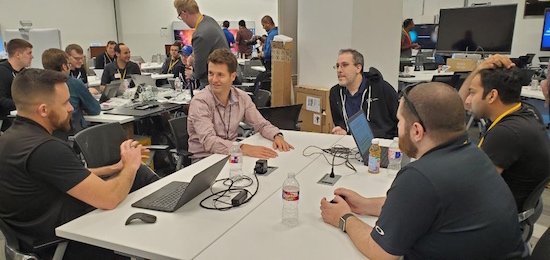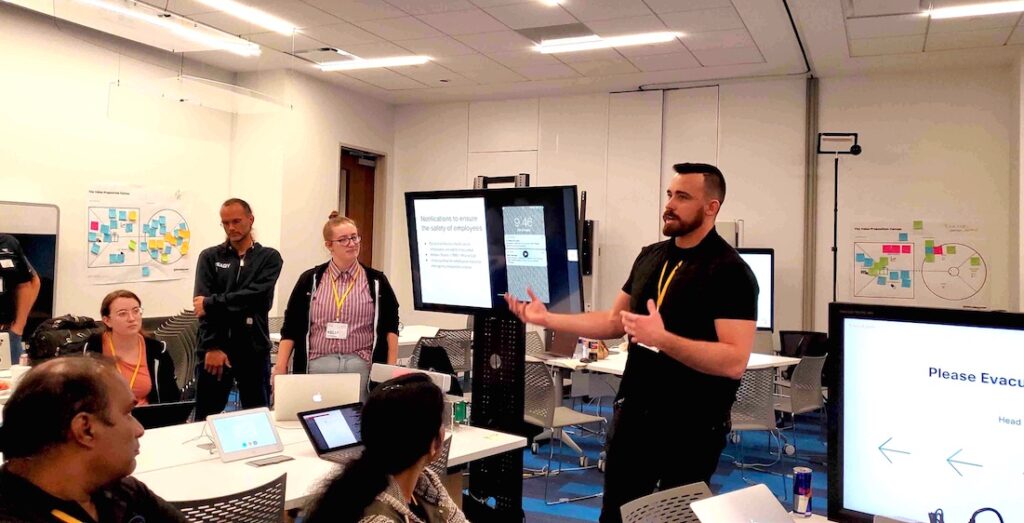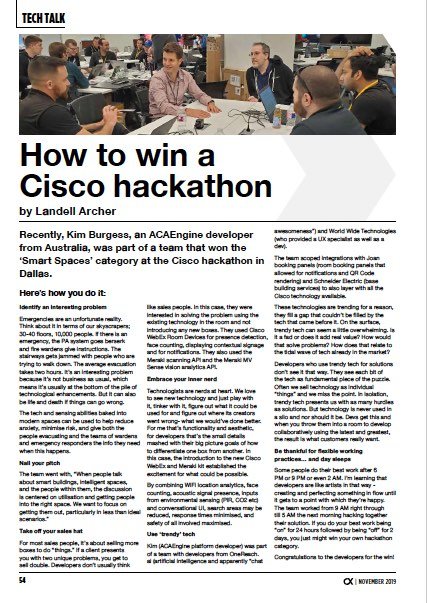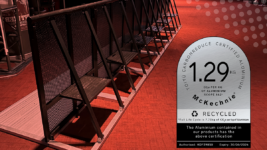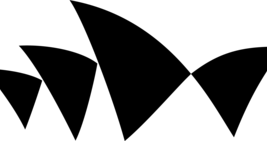Subscribe to CX E-News
TECH TALK
How to win a Cisco hackathon
by Landell Archer.
Recently, Kim Burgess, an ACAEngine developer from Australia, was part of a team that won the ‘Smart Spaces’ category at the Cisco hackathon in Dallas.
Here’s how you do it:
Identify an interesting problem
Emergencies are an unfortunate reality. Think about it in terms of our skyscrapers; 30-40 floors, 10,000 people. If there is an emergency, the PA system goes berserk and fire wardens give instructions. The stairways gets jammed with people who are trying to walk down.
The average evacuation takes two hours. It’s an interesting problem because it’s not business as usual, which means it’s usually at the bottom of the pile of technological enhancements. But it can also be life and death if things can go wrong.
The tech and sensing abilities baked into modern spaces can be used to help reduce anxiety, minimise risk, and give both the people evacuating and the teams of wardens and emergency responders the info they need when this happens.
Nail your pitch
The team went with, “When people talk about smart buildings, intelligent spaces, and the people within them, the discussion is centered on utilisation and getting people into the right space. We want to focus on getting them out, particularly in less than ideal scenarios.”
Take off your sales hat
For most sales people, it’s about selling more boxes to do “things.” If a client presents you with two unique problems, you get to sell double.
Developers don’t usually think like sales people. In this case, they were interested in solving the problem using the existing technology in the room and not introducing any new boxes.
They used Cisco WebEx Room Devices for presence detection, face counting, displaying contextual signage and for notifications. They also used the Meraki scanning API and the Meraki MV Sense vision analytics API.
Embrace your inner nerd
Technologists are nerds at heart. We love to see new technology and just play with it, tinker with it, figure out what it could be used for and figure out where its creators went wrong – what we would’ve done better.
For me that’s functionality and aesthetic, for developers that’s the small details mashed with their big picture goals of how to differentiate one box from another.
In this case, the introduction to the new Cisco WebEx and Meraki kit established the excitement for what could be possible. By combining WiFi location analytics, face counting, acoustic signal presence, inputs from environmental sensing (PIR, CO2 etc) and conversational UI, search areas may be reduced, response times minimised, and safety of all involved maximised.
Use ‘trendy’ tech
Kim (ACAEngine platform developer) was part of a team with developers from OneReach. ai (artificial intelligence and apparently “chat awesomeness”) and World Wide Technologies (who provided a UX specialist as well as a dev).
The team scoped integrations with Joan booking panels (room booking panels that allowed for notifications and QR Code rendering) and Schneider Electric (base building services) to also layer with all the Cisco technology available.
These technologies are trending for a reason, they fill a gap that couldn’t be filled by the tech that came before it. On the surface, trendy tech can seem a little overwhelming. Is it a fad or does it add real value? How would that solve problems? How does that relate to the tidal wave of tech already in the market?
Developers who use trendy tech for solutions don’t see it that way. They see each bit of the tech as fundamental piece of the puzzle. Often we sell technology as individual “things” and we miss the point.
In isolation, trendy tech presents us with as many hurdles as solutions. But technology is never used in a silo and nor should it be. Devs get this and when you throw them into a room to develop collaboratively using the latest and greatest, the result is what customers really want.
Be thankful for flexible working practices… and day sleeps
Some people do their best work after 6PM or 9PM or even 2AM. I’m learning that developers are like artists in that way – creating and perfecting something in flow until it gets to a point with which they’re happy.
The team worked from 9AM right through till 5AM the next morning hacking together their solution. If you do your best work being “on” for 24 hours followed by being “off” for 2 days, you just might win your own hackathon category.
Congratulations to the developers for the win!
CX Magazine – Nov 2019 Entertainment technology news and issues for Australia and New Zealand – in print and free online www.cxnetwork.com.au
© CX Media
Subscribe
Published monthly since 1991, our famous AV industry magazine is free for download or pay for print. Subscribers also receive CX News, our free weekly email with the latest industry news and jobs.


